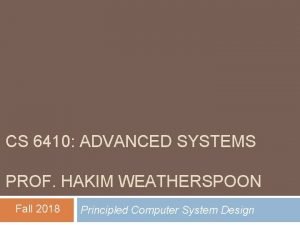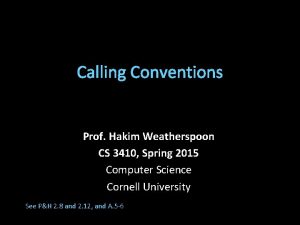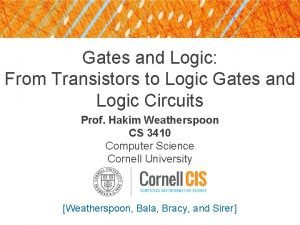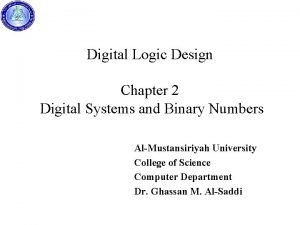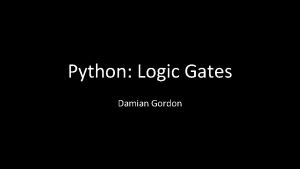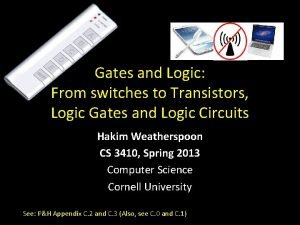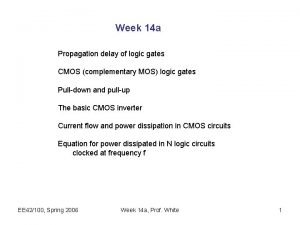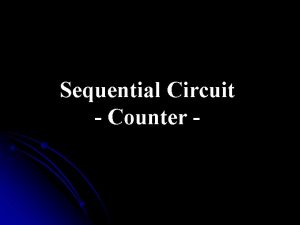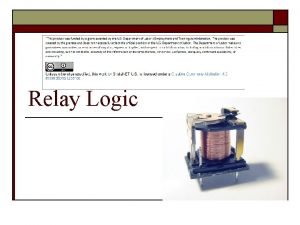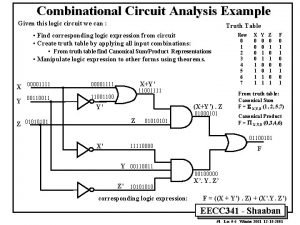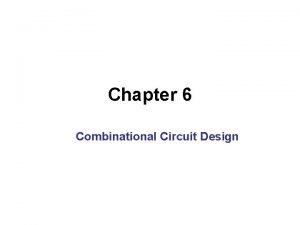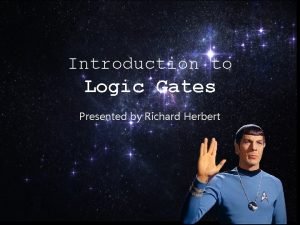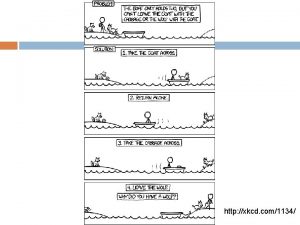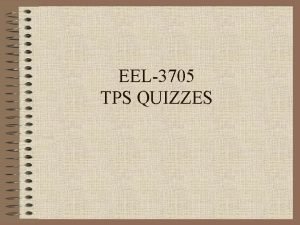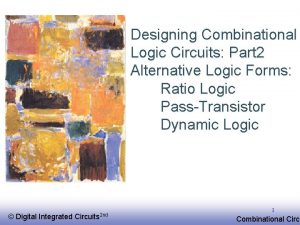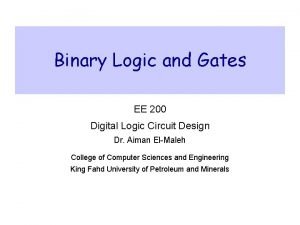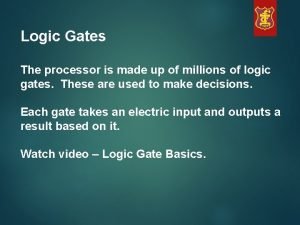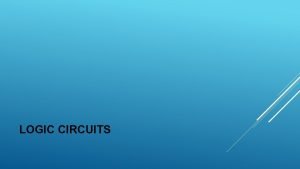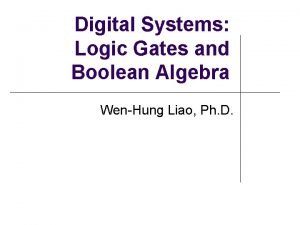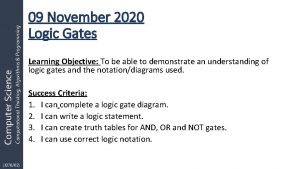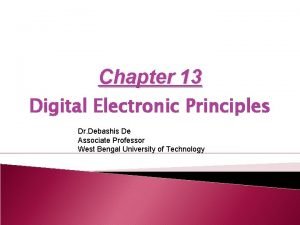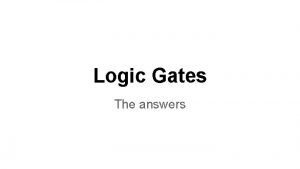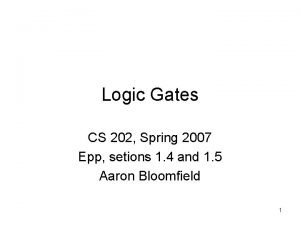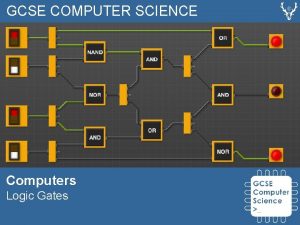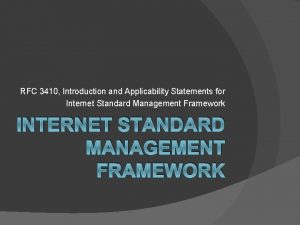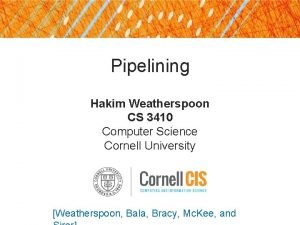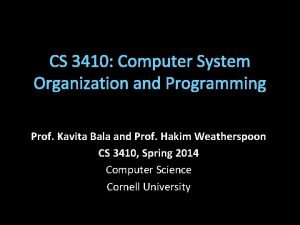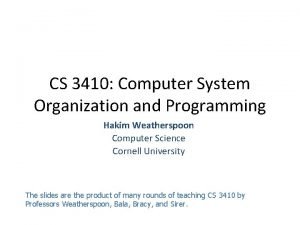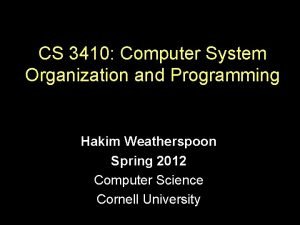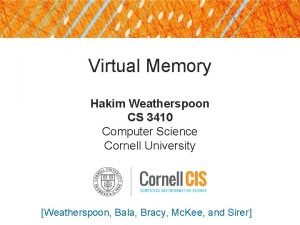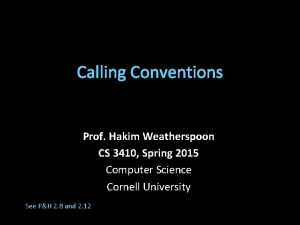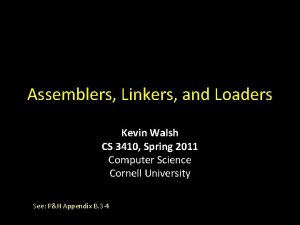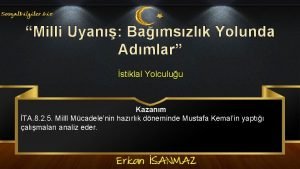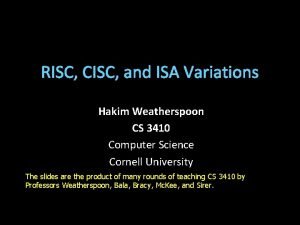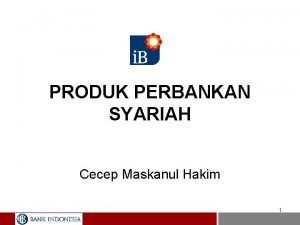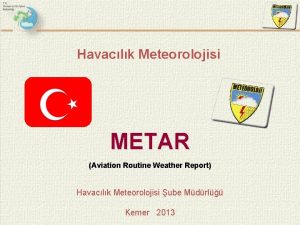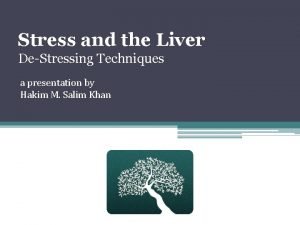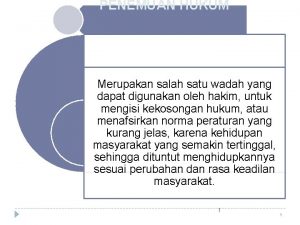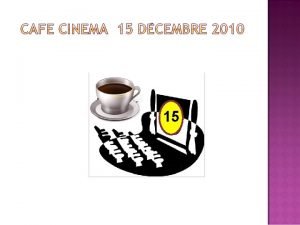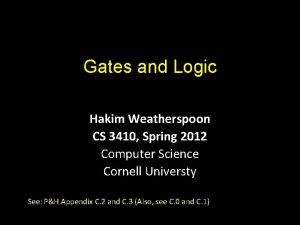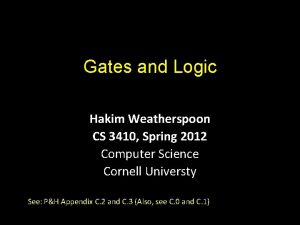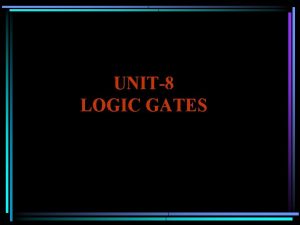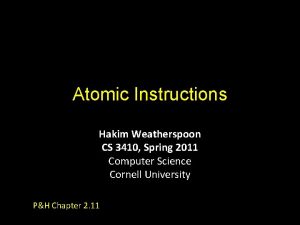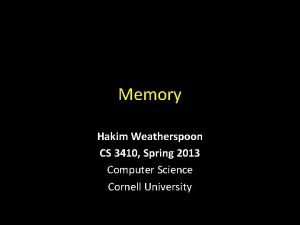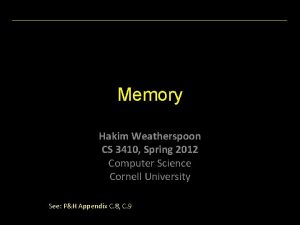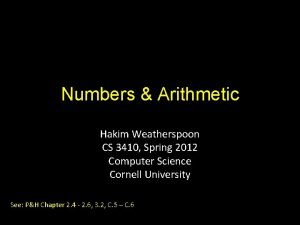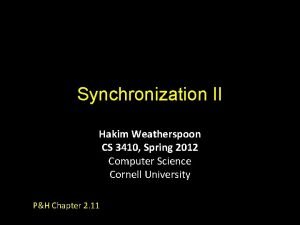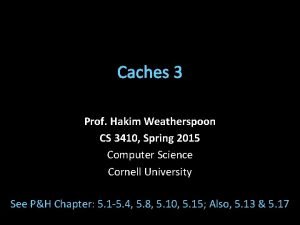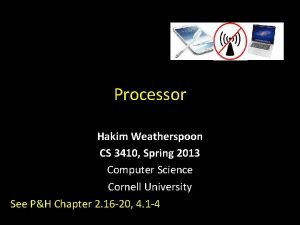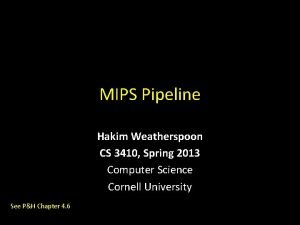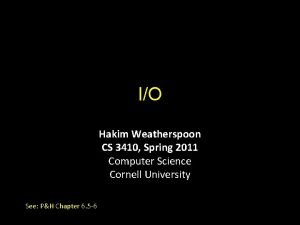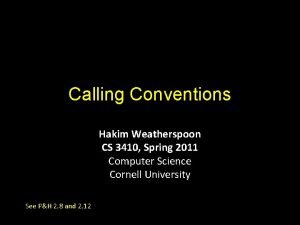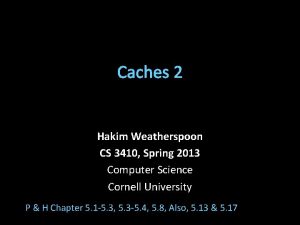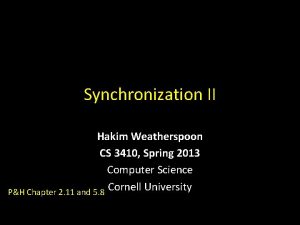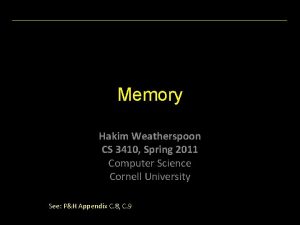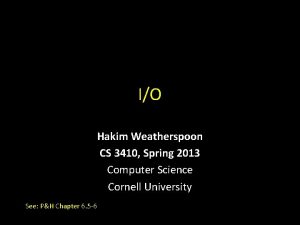Gates and Logic Hakim Weatherspoon CS 3410 Spring





















































- Slides: 53

Gates and Logic Hakim Weatherspoon CS 3410, Spring 2011 Computer Science Cornell Universty See: P&H Appendix C. 0, C. 1, C. 2

Gates and Logic See: P&H Appendix C. 0, C. 1, C. 2 http: //www. xkcd. com/74/

Announcements Class newsgroup created • Posted on web-page • Use it for partner finding First assignment is to find partners Sections start next week • Use this weeks section to find a partner Note about class • No Verilog or VHDL • Clickers not required, but will use them from time-to-time 3

A switch • Acts as a conductor or insulator • Can be used to build amazing things… 4

Better Switch • One current controls another (larger) current • Static Power: – Keeps consuming power when in the ON state • Dynamic Power: – Jump in power consumption when switching 5

Atoms e e e PNN P P PN P NN NPNP e e hole e e 6

Elements e e e Boron e e e Silicon e P e e e Phosphorus 7

e e e Si e e Si e e e Silicon Crystal Silicon e e e e Si e e Si e e Si e e Si e e Si e e e e e e e e e e Si e e Si e e e e Si e e Si e e e 8

Phosphorus Doping e e e e e N-Type: e e. Silicon e + Phosphorus e e e e e e e ee e e P e e e e e e e e e e e e P e e e ee e e e e e P e e ee e e e 9

Boron Doping e e e e e e Silicon e. P-Type: e e e e e e e e B e e e e e e B e e e +e Boron e e e e B e e e e e e e e e e 10

Semiconductors Insulator p-type (Si+Boron) has mobile holes: low voltage (depleted) → insulator high voltage (mobile holes) → conductor n-type (Si+Phosphorus) has mobile electrons: low voltage (mobile electrons) → conductor high voltage (depleted) → insulator 11

Bipolar Junction P-Type N-Type e e e low v → insulator high v → conductor e low v → conductor high v → insulator 12

Reverse Bias P-Type N-Type e e – e e e e low v → insulator high v → conductor + e low v → conductor high v → insulator 13

Forward Bias P-Type N-Type e e e + e e e e e low v → insulator high v → conductor e e – e e low v → conductor high v → insulator 14

Diodes PN Junction “Diode” p-type Conventions: vdd = vcc = +1. 2 v = +5 v = hi vss = vee = 0 v = gnd n-type 15

PNP Junction p-type n-type p-type 16

Bipolar Junction Transistors • Solid-state switch: The most amazing invention of the 1900 s Emitter = “input”, Base = “switch”, Collector = “output” PNP Transistor C p n p E=vdd NPN Transistor vss=E n p n B E B C B vdd C B C E vss 17

Field Effect Transistors P-type FET N-type FET Drain = vdd Gate Drain Gate Source Connect Source to Drain when Gate = lo • Drain must be vdd, or connected to source of another P-type transistor • Source = vss Connect Source to Drain when Gate = hi • Source must be vss, or connected to drain of another N-type transistor • 18

Multiple Transistors +5 v Vdd in out Vss In Out 0 v t Gate delay • transistor switching time • voltage, propagation, fanout, temperature, … CMOS design (complementary-symmetry metal–oxide– voltage semiconductor) Power consumption = dynamic + leakage 19

Digital Logic +5 v Vdd in out Vss +2 v +0. 5 v 0 v t In Out +5 v 0 v 0 v +5 v In Out voltage truth table Conventions: vdd = vcc = +1. 2 v = +5 v = hi = true = 1 vss = vee = 0 v = gnd = false = 0 20

NOT Gate (Inverter) Function: NOT Symbol: Vdd in out Vss In Out 0 1 1 0 Truth table 21

NAND Gate Vdd A Function: NAND Symbol: Vdd B out B A a b out A B out Vss 0 0 1 1 0 22

NOR Gate Function: NOR Symbol: Vdd A a b B out B A Vss A B out Vss 0 0 1 1 0 0 0 23

Building Functions • AND: • OR: • NOT: 24

Universal Gates NAND is universal (so is NOR) • Can implement any function with just NAND gates – De Morgan’s laws are helpful (pushing bubbles) • useful for manufacturing E. g. : XOR (A, B) = A or B but not both (“exclusive or”) Proof: ? 25

Logic Equations Some notation: • constants: true = 1, false = 0 • variables: a, b, out, … • operators: = a&b = a b OR(a, b) = a + b = a | b • NOT(a) = ā = !a =a b = a • AND(a, b) = a b • 26

Identities useful for manipulating logic equations – For optimization & ease of implementation a+0= a a+1= 1 a+ā= 1 a 0= 0 a 1= a aā= 0 (a + b) = a b (a b) = a + b a+ab= a a(b+c) = ab + ac a(b+c) = a + bc 27

Logic Manipulation • • functions: gates ↔ truth tables ↔ equations Example: (a+b)(a+c) = a + bc a b c 0 0 0 1 1 1 0 0 1 1 1 28

Logic Manipulation • • functions: gates ↔ truth tables ↔ equations Example: (a+b)(a+c) = a + bc a b c a+b a+c LHS bc RHS 0 0 0 0 0 1 0 1 0 0 0 0 0 1 1 1 1 0 0 1 1 1 0 1 1 1 1 1 29

30

Logic Minimization • A common problem is how to implement a desired function most efficiently • One can derive the equation from the truth table a b c minterm for all outputs 0 0 0 abc that are 1, 0 0 1 abc take the corresponding 0 1 0 abc minterm 0 1 1 abc 1 0 0 abc Obtain the result in 1 0 1 abc “sum of products” form 1 1 0 abc 1 1 1 abc • How does one find the most efficient equation? – Manipulate algebraically until satisfied – Use Karnaugh maps (or K maps)

Multiplexer a • A multiplexer selects between multiple inputs 0 – out = a, if d = 0 – out = b, if d = 1 b d • Build truth table • Minimize diagram • Derive logic diagram

Multiplexer Implementation a 0 • Build a truth table b = abd + a b d = ad + bd d a b d out 0 0 0 1 1 0 0 1 1 1

Multiplexer Implementation a 0 • Draw the circuit b d a b d out 0 0 0 1 1 0 0 1 1 1 – out = ad + bd a d b out

Logic Gates • One can buy gates separately – ex. 74 xxx series of integrated circuits – cost ~$1 per chip, mostly for packaging and testing • Cumbersome, but possible to build devices using gates put together manually

Integrated Circuits • Or one can manufacture a complete design using a custom mask • Intel Nehalem has approximately 731 million transistors

Voting machine • Build something interesting • A voting machine • Assume: – A vote is recorded on a piece of paper, – by punching out a hole, – there at most 7 choices – we will not worry about “hanging chads” or “invalids”

Voting machine • For now, let’s just display the numerical identifier to the ballot supervisor – we won’t do counting yet, just decoding – we can use four photo-sensitive transistors to find out which hole is punched out • A photo-sensitive transistor detects the presence of light • Photo-sensitive material triggers the gate

Ballot Reading – Input: paper with a hole in it – Out: number the ballot supervisor can record Ballots The 3410 vote recording machine

Encoders a 1 b c d 2 3 4 e 5. . A 3 -bit encoder (7 -to-3) (5 inputs shown) o 0 o 1 o 2 • N sensors in a row • Want to distinguish which of the N sensors has fired • Want to represent the firing sensor number in compact form – N might be large – Only one wire is on at any time – Silly to route N wires everywhere, better to encode in log N wires

Number Representations 37 1 10 0 10 • Decimal numbers are written in base 10 – 3 x 101 + 7 x 100 = 37 • Just as easily use other bases – Base 2 - “Binary” – Base 8 - “Octal” – Base 16 – “Hexadecimal”

Number Representations 37 1 10 0 10 • Base conversion via repetitive division – Divide by base, write remainder, move left with quotient – Sanity check with 37 and base 10

Binary Representation • Check 37 and base 2 • 37 = 32 + 4 + 1 0100 101 26 25 24 23 22 21 20 64 32 16 8 4 2 1

Hexadecimal Representation • 37 decimal = (25)16 • Convention 25 161 160 – Base 16 is written with a leading 0 x – 37 = 0 x 25 • Need extra digits! – 0, 1, 2, 3, 4, 5, 6, 7, 8, 9, A, B, C, D, E, F • Binary to hexadecimal is easy – Divide into groups of 4, translate groupwise into hex digits

Encoder Truth Table a b 1 o 0 2 o 1 c 3 d 4 a b c d o 2 o 1 o 0 0 0 0 1 0 0 0 1 1 0 0 o 2 A 3 -bit encoder with 4 inputs for simplicity • o 2 = abcd • o 1 = abcd + abcd • o 0 = abcd + abcd

Ballot Reading • Ok, we built first half of the machine • Need to display the result Ballots The 3410 voting machine

7 -Segment LED Decoder • 4 inputs encoded in binary • 8 outputs, each driving an independent, rectangular LED • Can display numbers • Just a simple logic circuit • Write the truth table

7 -Segment LED Decoder 1 0 0 0 • 4 inputs encoded in binary • 8 outputs, each driving an independent, rectangular LED • Can display numbers

7 -Segment LED Decoder 1 0 • 4 inputs encoded in binary • 8 outputs, each driving an independent, rectangular LED • Can display numbers

7 -Segment Decoder Truth Table i 3 i 2 i 1 i 0 o 1 o 2 o 3 o 4 o 5 o 6 0 0 1 1 1 0 0 0 1 0 1 1 1 0 0 0 1 1 0 0 1 1 0 0 1 0 1 1 0 0 0 1 1 1 1 1 0 0 0 1 1 1 1 0 0 1 1 1 0 1 1 o 2 o 0 o 3 o 4 o 6 o 5 Exercise: find the error(s) in this truth table

7 -Segment Decoder Truth Table i 3 i 2 i 1 i 0 o 1 o 2 o 3 o 4 o 5 o 6 0 0 1 1 1 0 0 0 1 0 1 1 1 0 0 0 1 1 0 0 1 1 0 0 1 0 1 1 0 0 0 1 1 1 1 1 0 0 0 1 1 1 1 0 0 1 1 1 0 1 1 o 2 o 0 o 3 o 4 o 6 o 5 Exercise: find the error(s) in this truth table

Ballot Reading • Done! Ballots The 3410 voting machine

Summary • We can now implement any logic circuit – Can do it efficiently, using Karnaugh maps to find the minimal terms required – Can use either NAND or NOR gates to implement the logic circuit – Can use P- and N-transistors to implement NAND or NOR gates
 Cs6410
Cs6410 Caller save vs callee save
Caller save vs callee save Timing diagram for logic gates
Timing diagram for logic gates Which gate
Which gate Binary code
Binary code Python and gate
Python and gate Logic gates and
Logic gates and Propagation delay formula
Propagation delay formula Parking counter using logic gates
Parking counter using logic gates Nand relay
Nand relay Combinational logic gates truth tables
Combinational logic gates truth tables Compound logic gate
Compound logic gate Logic gates minecraft
Logic gates minecraft Logic.ly demo
Logic.ly demo Xkcd logic gates
Xkcd logic gates Logic gates truth table quiz
Logic gates truth table quiz Alternative logic gates
Alternative logic gates Precedence of logic gates
Precedence of logic gates Processor logic gates
Processor logic gates Aircraft logic circuit
Aircraft logic circuit For complex gate design in cmos or
For complex gate design in cmos or Nand boolean algebra
Nand boolean algebra Gdqblmdkgw4 -site:youtube.com
Gdqblmdkgw4 -site:youtube.com Characteristics of logic gates
Characteristics of logic gates Logic gates
Logic gates Logic gates
Logic gates Logic gates gcse
Logic gates gcse Logic
Logic Giduk
Giduk Months of spring summer autumn winter
Months of spring summer autumn winter Rfc3410
Rfc3410 Cornell cs 3410
Cornell cs 3410 Cornell cs 3410
Cornell cs 3410 Cs 3410
Cs 3410 Cs 3410
Cs 3410 Cs 3410
Cs 3410 Cs 3410
Cs 3410 Cs 3410
Cs 3410 Kuva-yi milliye'yi amil ve milli iradeyi hakim kılma
Kuva-yi milliye'yi amil ve milli iradeyi hakim kılma Dedi budiman hakim
Dedi budiman hakim Hakim isa
Hakim isa Cecep maskanul hakim
Cecep maskanul hakim Few sct bkn
Few sct bkn Wasim hakim
Wasim hakim Hakim salim khan
Hakim salim khan Nazar al-nafi’at adalah nama dari
Nazar al-nafi’at adalah nama dari Hakim abdul hameed
Hakim abdul hameed Argumentum per analogiam
Argumentum per analogiam Resisue
Resisue Dr mazen al hakim
Dr mazen al hakim Hakim boulouiz
Hakim boulouiz First order logic vs propositional logic
First order logic vs propositional logic First order logic vs propositional logic
First order logic vs propositional logic First order logic vs propositional logic
First order logic vs propositional logic
